
Nothofagus antarctica is a deciduous tree or shrub native to southern Chile and Argentina from about 36°S to Tierra del Fuego, where it grows mainly in the diminishing temperate rainforest.

Nothofagus pumilio, the lenga beech, is a deciduous tree or shrub in the Nothofagaceae family that is native to the southern Andes range, in the temperate forests of Chile and Argentina to Tierra del Fuego, from 35° to 56° South latitude. This tree is in the same genus as the coihue. It regenerates easily after fires. The wood is of good quality, moderate durability, and is easy to work with. It is used in furniture, shingles and construction and sometimes as a substitute for American black cherry in the manufacturing of cabinets.

Berberis microphylla, common name box-leaved barberry and Magellan barberry, in Spanish calafate and michay and other names, is an evergreen shrub, with simple, shiny box-like leaves. The calafate is native to southern Argentina and Chile and is a symbol of Patagonia. Berberis microphylla should not be confused with Mahonia microphylla, native to China.

Nothofagus dombeyi, Dombey's beech, coigue, coihue or coigüe is a tree species native to southern Chile and the Andean parts of Argentine Patagonia. It is a fast-growing species that can live in a wide range of climatic conditions, and forms dense forests. It is cultivated for its timber, and as an ornamental subject.
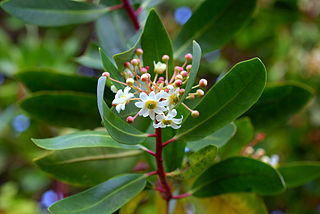
Drimys winteri, also known as Winter's bark, foye and canelo, is a slender species of tree in the family Winteraceae, growing up to 20 m (66 ft) tall. It is native to the Magellanic and Valdivian temperate forests of Chile and Argentina, where it is a dominant tree in the coastal evergreen forests. It is found below 1,200 m (3,900 ft) between latitude 32° south and Cape Horn at latitude 56°. In its southernmost natural range it can tolerate temperatures down to −20 °C (−4 °F). The plant is renowned for its phenotypic plasticity being able to grow in different sites from "extreme arid zones to wetlands along Chile". The tree does also grow in places with various types and degrees of competition from other plants.

Maytenus magellanica is a small evergreen tree from the genus Maytenus, up to 5 meters (16 ft), in the Celastraceae. It grows in southern Argentina and Chile from 36ºS to Cape Horn (56ºS).

Nothofagus glauca, commonly known as hualo or roble Maulino, is a species of plant in the family Nothofagaceae. It is a deciduous tree endemic to Chile. It grows from 34° to 37° South latitude. It is a typical tree of the maritime mediterranean-climate Maulino forest of Central Chile, its current range spanning over 330 km from north to south. The species grows on a variety of soils and is mostly found on gentle to steep slopes.

Gevuina avellana, commonly known as the Chilean hazelnut or Gevuina hazelnut, is an evergreen tree growing up to 20 meters tall. It is the only species currently classified in the genus Gevuina. It is native to southern Chile and adjacent valleys in Argentina. It is found from sea level to 700 meters above sea level. Its distribution extends from 35° to 44° south latitude. The composite leaves are bright green and toothed, and the tree is in flower between July and November. The flowers are very small and beige to whitish, are bisexual and group two by two in long racemes. The fruit is a dark red nut when young and turns black. The peel is woody. It can grow up straight or branched from the soil, making up either a tree or a shrub.

Nothofagus nitida is an evergreen tree, native to southern Chile and Argentina. It is found from latitude 40° S to Última Esperanza.

Citronella mucronata, the huillipatagua, naranjillo, or Chilean citronella tree, is an evergreen tree endemic to Chile. It grows in the Chilean matorral region of central Chile from 30º to 40° south latitude.
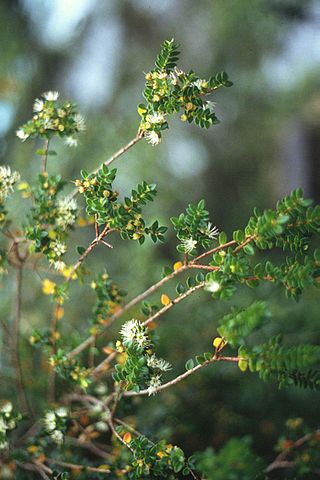
Metrosideros stipularis is a species of the myrtle family commonly known as tepú, trepú, or tepual. It is an evergreen tree or shrub that can attain a height of about seven metres. The plant is native to southern South America in the southern portions of Chile and Argentina and is a typical resident of very wet areas, especially peat bogs. Tepú has white flowers that emerge during the austral summer from January through March. The tree's wood is used within its range as a firewood due to it high energy content. This species has often been placed in its own genus Tepualia, but recent works include it in Metrosideros.
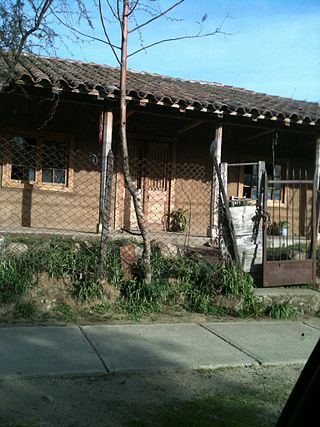
María José Reyes Moore and Juan René Duarte Becerra were murdered in July 2012 in an antique shop in Lolol, Colchagua Province, O'Higgins Region, Chile. Both victims had visited the shop as customers and were attacked and decapitated by shop owner Óscar López Rodríguez.
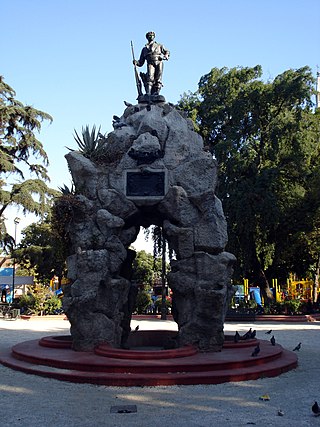
Plaza Yungay is a square located in Barrio Yungay, an historical neighborhood of Santiago, Chile, located at the western limits of the commune of Santiago. The plaza is the home of a monument commemorating the end of Chile's War of the Confederation (1836-1839) against the Peruvian and Bolivian confederation, and a church named for the saint that protects Santiago's residents from earthquakes. Today, it is a lively public space.

Rebeca del Rosario Cofré Calderón is a Chilean politician and member of the Independent Democrat Union (UDI). In 2008 she was elected mayor of Chépica, a small commune in Colchagua Province, after running unsuccessfully for the same office four years before. She was re-elected to the office in 2012. In 2013, she was named as one of the 100 Leading Women of Chile by Mujeres Empresarias and the Economía y Negocios section of El Mercurio newspaper.

Alicia Morel Chaigneau was a Chilean writer, novelist, storyteller, poet, and essayist best known for her work in the field of children's literature and theater for children and puppets.

Jürgen Rottmann is a Chilean ornithologist and conservationist. He is a founding member of the Chilean Committee for the Defence of Flora and Fauna and director of the Chilean Union of Ornithologists. He is the founder of the Raptor Rehabilitation Center located at his own farm in Talagante and scientific director of the Gaviotin Chico Sustainability Foundation.

Neva Milicic Müller is a Chilean child psychologist, known for her publications of children's books and her academic work. She was named an emerita professor at the Pontifical Catholic University of Chile in 2014.

Andrea Molina Oliva is a Chilean actress, businesswoman, and politician. Early in her acting career, she gained popularity for her starring role in Las historias de Sussi, a TV series adapted from the film Sussi. She later appeared on the service program Hola Andrea and Mujer, rompe el silencio, a program that dealt with cases of gender violence.
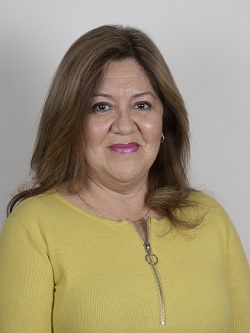
María Nora Cuevas Contreras is a Chilean public relations officer and politician of the Independent Democratic Union (UDI). She has been a member of the Chamber of Deputies for District 14 since August 2020. She previously served as a councilor of San Bernardo from 2000 to 2008, and its mayor from 2008 to 2020.



















